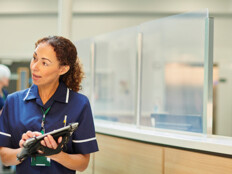Q&A: Joel Shoolin on the Benefits, Challenges of Mobility in Healthcare
In today’s data-focused healthcare environment, mobility empowers both clinicians and patients, helping to improve outcomes and the patient experience. Clinicians expect anywhere, anytime access to patient records via smartphones, tablets or notebooks in order to speed diagnosis and treatment, and consumers are quickly jumping on the mHealth bandwagon themselves.
What are the biggest benefits — and challenges — of mobility? What steps should you take to ensure reliable mobile access while still protecting data, networks and devices? How can healthcare organizations take mobility to the next level?
In an interview with HealthTech, FHN Healthcare Chief Medical Information Officer Joel Shoolin discusses the value mobility brings to his regional healthcare system, which serves residents in northwest Illinois and southern Wisconsin through its hospital, family healthcare and specialty care locations.
HEALTHTECH: What trends do you see driving the need for increased clinical mobility?
SHOOLIN: I think it’s being driven by the marketplace and the needs and desires of physicians and patients who are getting accustomed to mobility as “the way of the world.” There’s a lot of information that can be gleaned from smaller mobile devices. Younger physicians, in particular, are accustomed to having their smartphones and don’t want to be tied down to a desktop computer. In addition, patients now have expectations that physicians will bring a tablet or notebook into the office suite or the hospital room.
HEALTHTECH: What do you see as the biggest benefits of this growing mobility?
SHOOLIN: Mobility provides another level of accessibility to information and a certain level of security, as well. If you take a mobile device with you out of the room, there’s no opportunity for someone else to access it, as would be the case if you stepped away and left your desktop on. Another benefit is the ability to reach out to patients through Facebook, Twitter or other social media platforms, which I feel tend to be accessed more on the run through mobile devices than by someone sitting at a stationary computer.
HEALTHTECH: What challenges does mobility present to healthcare organizations like yours?
SHOOLIN: Connectivity continues to be a challenge in many spaces. We have an expectation that our devices are going to work everywhere, and that doesn’t always happen. The goal is to implement a wireless network that works all the time, even in typically inaccessible places like a stairwell or elevator. I equate this to decorating your house. You can put on new wallpaper and paint, but you also have to take care of the plumbing and electricity behind the walls. So it can sometimes be challenging to balance an IT department’s need to take care of this infrastructure with clinicians’ desire for new devices. It takes time, money and effort to make sure the wireless network is complete and mobile devices have the necessary wireless accessibility, both internally and externally.
HEALTHTECH: What point-of-care solutions are FHN clinicians using currently?
SHOOLIN: Clinicians are using tablets and notebooks in their outpatient settings, and some use them during inpatient rounds, as well. For the future, we’re looking at using a third party to implement and manage some remote patient monitoring. This might include leveraging exercise monitors for wellness, scales for patients in weight management programs or glucose meters for patients with diabetes. Our goal is to work out some interfaces with the monitoring devices so the data can feed directly into our EMR [electronic medical records] and enable us to track trends.
HEALTHTECH: What steps does FHN take to protect sensitive patient data against the threat of breach?
SHOOLIN: Encryption is standard at this point. We have to take that extra step to make sure every device getting access to the EMR automatically has encryption associated with it. Based on a security audit we conducted, we’ve also changed our password policy to require more complex passwords. Another important strategy is setting up appropriate firewalls, given that so many systems are interconnected. You don’t want unauthorized people accessing your EMR by hacking into your heating and air-conditioning management software, for example. The fear of a data breach is a huge driver for mobility management and security, even bigger than purely financial ROI [return on investment].
HEALTHTECH: What do you think clinical mobility will look like at FHN five years down the road?
SHOOLIN: We’re in the process of upgrading to a new level of our EMR, which has a unique mobile ambulatory software program. It has the look and feel of typical mobile applications, which makes using mobile devices within the context of patient management much more desirable. I think as we look toward the future, more devices and applications are going to interface with our EMR. The ability to integrate that data will give us a leg up on population health management.
HEALTHTECH: What tips would you offer your peers looking to take clinical mobility to the next level?
SHOOLIN: First of all, mobility is a bit like a train racing down the track — you need to be prepared because it’s coming and if you’re not ready, you’re going to be left behind. Second, vendors also need to up their game in terms of mobile applications because that’s what people need and want. Third, clinicians need access to patient data anywhere, anytime, and if you’re on call, powering up your desktop computer isn’t nearly as convenient as powering up your tablet. Patients expect us to have access to information at our fingertips. These are the key drivers that I’m seeing, for which every health organization should be prepared.








